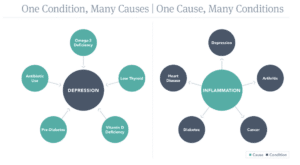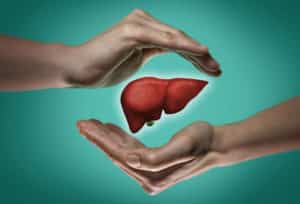If you’ve ever dealt with hormone issues, you know how powerful hormones can be! They can leave you crying in a corner when you know what’s making you upset isn’t as big as it feels. One minute you’re edgy, anxious, and irritable and the next you feel overwhelmed with fatigue. The worst part is feeling powerless over your mood!
The mood swings were probably the hardest part for me. The unsettled edginess for days, and then the crushing fatigue. Ladies, let’s face it – we’ve got lives to live… Careers to rock… kids to wake up to… And not knowing what mood is going to hit you from day to day or moment to moment is just not g0ing to cut it. And guess what, you are not alone…
43% of women report that hormones have negatively impacted their well being (1), and this is sad because there are so many things that can be addressed to support healthy hormone balance. So, let’s dive in.
This is Part 1 of a four part series on balancing hormones naturally. In this article, we’ll delve into many of the common ways women try to balance hormones that often don’t work and why. This will help you understand why you might be dealing with hormone problems if you’ve already taken steps to address what’s going on.
I do have a video of this article if you’d rather listen or watch the content. Just scroll to the bottom of this page, and you can view the video there.
When it comes to hormone balance, there are three things that a lot of people try that often fail…
We’re going to go through three of the big ones:
- Hormonal Birth Control
- Eating TOO low carb (which can be helpful for some people, but NOT ALL)
- Exercising More
We’ll go through all three of these in depth, and remember that in some cases of hormone imbalance some of these may be helpful. It’s why we always want to assess for the root causes of hormone imbalance, which we’ll get into in Part 2. In the meantime, these are some common go-to’s that many women have tried which can leave them frustrated without the improvement they were hoping to see. So, let’s discuss them and why they don’t always work…
#1: Hormonal Birth Control:
The pill has been wonderful for women in a multitude of ways. It’s contributed to social and economic improvements for women. It’s allowed women to choose when or if they want to have a child, and it’s provided us the ability to work outside of the home. One study found that the pill is partly responsible for a 30% increase in women’s wages by the 1990s (2)! It also contributed to higher college enrollment and completion rate in the ’60s and ’70s.
However, the pill really hasn’t kept up with the times. It was initially prescribed to help prevent unwanted pregnancies from occurring. Women have complained of side effects throughout the years, but there’s been little improvement to the pill. Women prescribed the pill are more likely to be prescribed an antidepressant. The pill is associated with an increased risk of heart attack, autoimmune disease, thyroid, and adrenal disorders. Despite side effects to the pill, many women are not informed of these side effects before they choose to start taking it.
The pill is often prescribed for non-contraceptive reasons. Some of those include endometriosis, PCOS, painful periods, and acne. These issues are not due to a lack of synthetic hormones. They are due to underlying root causes, which we’ll discuss in more detail later.
Ever wondered how the pill works? There are different types, but typically the pill contains estrogen and progestin and these inhibit the body’s natural cyclic hormones. They stop the body from ovulating and cause some other changes that, in turn, prevent pregnancy.
I’m often asked:
“Why do I get a period when I’m on the pill if I’m not producing my natural cyclic hormones?”
This is due to the withdrawal of hormones during that week. That withdrawal causes a drop in the body’s hormones, which causes the lining of the uterus to shed, producing what seems like a period, but it’s not really equivalent to what would happen during a natural period.
For some women, the pill reduces unwanted symptoms, or is a preferred method for preventing pregnancy. For other women, you may be reading this because you’re considering discontinuing the pill. If you started taking the pill to deal with hormone issues, it may not be a good idea to stop taking it cold turkey. If the same root causes are present, you may get an unwanted return of symptoms. You can begin to address these at any point. This will help get those systems in the body functioning more effectively so that, if you do decide that you’re wanting to discontinue the pill, you can do it after you’ve discovered and begun to deal with them. If you’re using the pill for birth control, there are steps you can take to help with some of the side effects of the pill. We’ll talk about this in parts 3 & 4.
The second thing a lot of people do to try to balance their hormones that often doesn’t work is:
#2: Eating a Very Low Carb Diet:
Disclaimer that if the symptoms you’re experiencing of hormone imbalance are due to insulin resistance, then eating low carb or keto may be exactly what you need!
It’s important to discover the root causes for your symptoms so that you can choose an appropriate dietary approach. If you have HPA axis dysfunction, keto or low-carb is typically not a good starting approach to balance hormones. If thyroid issues are present this may also not be an ideal place to start. ALSO, for many pre-menopausal women, keto may work, but it may not work every day of the cycle. You may need to include some carbs on certain days to allow you to be low carb on other days. We’ll be discussing this in PART 3!
Let’s start with what HPA axis dysfunction is, and why keto or low carb may not be best in these cases. HPA axis stands for hypothalamic, pituitary, adrenal axis. Think adrenal fatigue. Think high levels of stress. Think high or low cortisol (a stress hormone)… or c0rtisol levels that don’t follow a healthy circadian rhythm. If there’s dysfunction with the HPA Axis, which is can be the cause for people feeling burnt out with energy issues, then we want to include sufficient amounts of complex carbohydrate in the diet. In these cases, typically including around 125-150 grams of complex carbohydrates from vegetables, fruits, and maybe gluten free grains can be a good place to start. Things can always be adjusted from there.
The reason for this is that when we eat keto or low carb, it causes a bit of an increase in cortisol. So, this means that a low carb diet could be a stressor in individuals already dealing with HPA Axis issues. Combine that with a stressful job, running around all day with kiddos, not getting enough sleep, and high intensity exercise, and you have a recipe for adrenal burnout. If you’re dealing with a lot of stress along with fatigue and poor sleep, then you may want to increase your carb intake until you get those stressors under control. Then later, after addressing stress levels and any root causes, it’s possible that a low carb or ketogenic approach could work.
Let’s talk about thyroid health!
Hypothyroidism is one of the most commonly cited reasons for needing to eat a moderate carb diet. The big reason for this is that carbs affect thyroid function directly. We need insulin for the conversion of inactive T4 hormone into active T3 hormone. Insulin is typically quite low on a low carb or a ketogenic diet, so if you start a keto or a low carb diet and you start developing hypothyroid symptoms, then this is a sign that you’re probably going to want to up your carbs or at least rotate them in periodically. If you already have a thyroid issue, then keto/low carb may not be the right approach for you. If you’ve started a low carb approach thinking it’ll help your energy and things worsen (after you’ve given yourself sufficient time to adjust to low carb), this can indicate that you may want to dig deeper into your HPA Axis and thyroid health. This can help you determine if some work needs to be done in these areas to help get you on track.
The good news is that our bodies shift as we address our root issues. I have a client who couldn’t eat low carb when we first started working together, but after a 8 months of working on her gut, hormones, and stress levels she was able to shift into a low carb diet with great success.
#3: Exercising More:
When we exercise, we’re inducing a stress response in the body. Cortisol, a stress hormone rises as we do our workout. After a stressor, the body has a natural relaxation response to that stress, meaning that after the stressor is over the body will shift into a parasympathetic response. This is the part of the nervous system where we feel relaxed. This is why exercise can help manage stress for many people. We actually induce a slight stressor and then our body shifts into a relaxation response (so long as we allow the time for this) after the exercise is complete.
However, if you’re burnt out and stressed, moderate to high intensity exercise may cause more problems than it’s helping. If we’ve been under stress for a long period of time we may be too “burnt out” for the degree of exercise (stress) that we’re inducing in the body.
Consider this… The human body considers long-term stress to be anything over a couple minutes. In our minds we might think of long-term stress as being months or years on end, but for the body, it’s actually just past a couple minutes. So, when we perceive a stressor, we release adrenaline and then, if that continues past a couple minutes, we start releasing cortisol. If this happens day after day, month after month, or even year after year, we can cause damage to the HPA Axis. To be clear, this stands for hypothalamic-pituitary-adrenal axis. Think of this as the communication of stress hormones in your body. As our body manages this long term stress, it tries to cope by making adjustments….our body is so smart! However, if the stressors are coming too often and for too long, the adaptations being made lead to blunted responses to stressors. If you’re experiencing this, you may find that your motivation is low, you feel burnt out, and you just can’t care as much about the actual things happening. OR, you may feel absolutely overwhelmed by stressors, unable to cope in ways that you used to.
SO, back to how this impacts exercise! If this is going on in the body, we need to remember that when we exercise, we’re inducing a stress response, and if our body is no longer responding well to stressors, this could add insult to injury. If you’re engaging in moderate to high intensity exercise for 30-60 minutes straight, and you have HPA Axis issues, you may notice that the exercise feels good in the moment, but later that day or the next day, you feel absolutely wiped. OR you may notice that you stay sore for much longer periods of time after exercising than you used to. Sometimes this is referred to as exercise intolerance. In this case, you could be stressing the HPA Axis even further, causing more problems for overall hormone balance. Appropriate exercise is the key… More exercise is not.
We’ll go more in depth into the types of exercise that are optimal for hormone issues in Part 4. It’s typically safe to do gentle movement practices like yoga or low impact activities like swimming. Walks out in nature are wonderful too!
Stay tuned for Part 2 in which we dig into the root causes for hormone problems. In parts 3 and 4 we’ll go into diet, lifestyle, and supplements to balance hormones naturally. See you soon lovely!
Here’s a discussion about this topic if you’d like to hear more!






